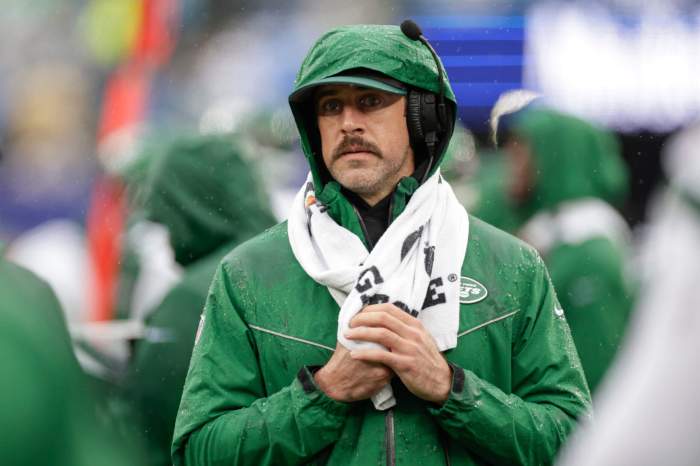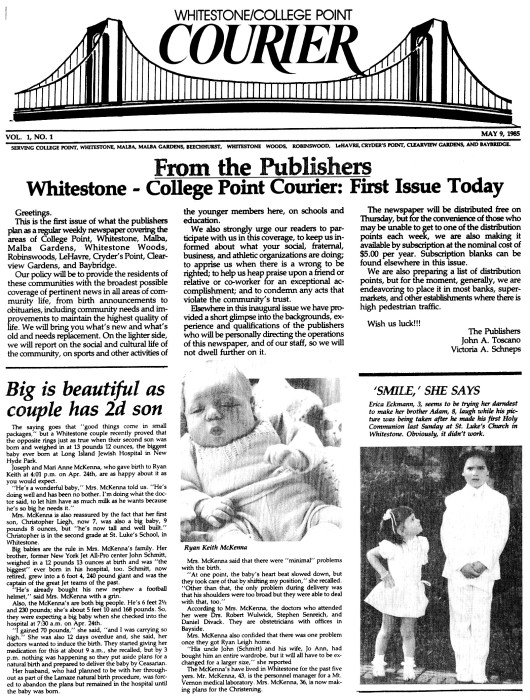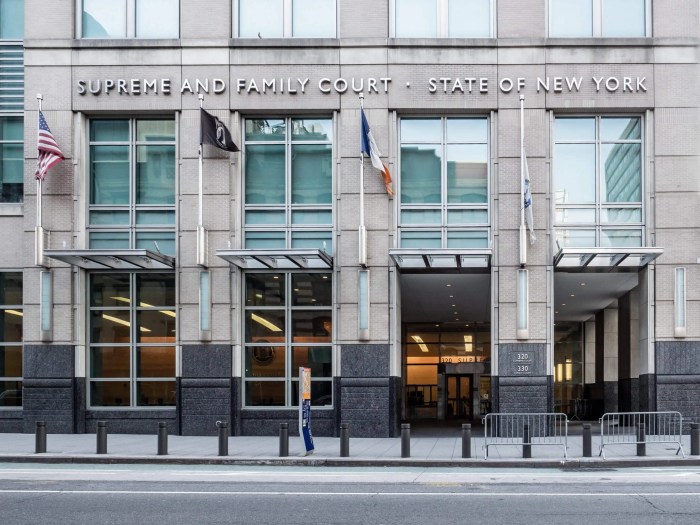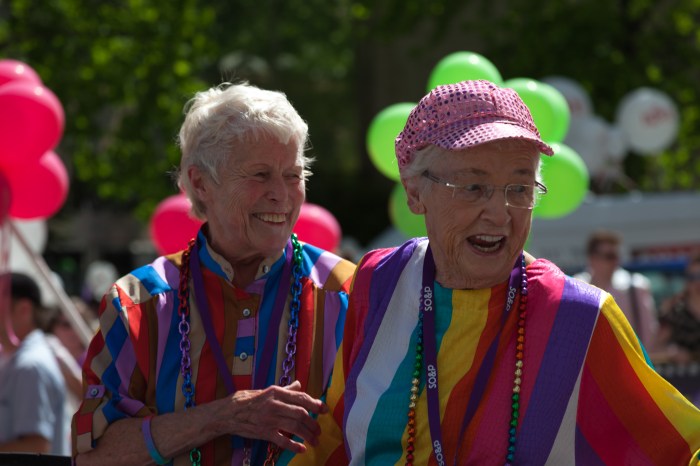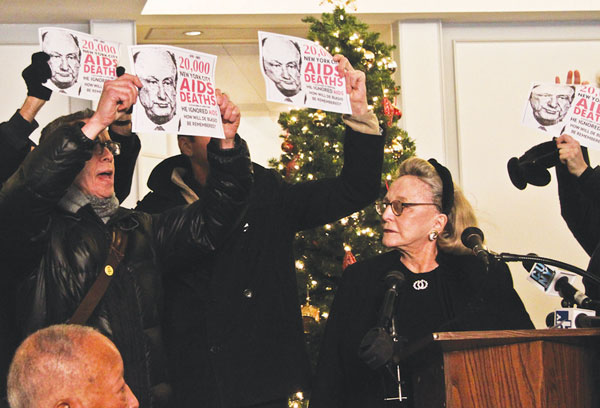
Photo by Tequila Minsky
BY LINCOLN ANDERSON | In a fiery flashback of 1980s AIDS activism, a ceremony to dedicate a commemorative plaque to former Mayor Ed Koch at 2 Fifth Ave. last Friday morning was disrupted by a chaotic protest by members of ACT UP.
As Barbaralee Diamonstein-Spielvogel, chairperson of the Historic Landmarks Preservation Center, the organization that sponsored the plaque, was giving remarks in the building’s lobby, she was surrounded by a handful of ACT UP members.
“Twenty-five years! Nothing for AIDS!” the protesters chanted, while holding up signs with an image of Koch reading, “20,000 New York City AIDS deaths. He ignored AIDS. How will de Blasio be remembered?”
The noisy demonstration continued briefly before building staff escorted the AIDS activists out of the premises.
Although Koch lived on Washington Place during his three terms as mayor — many say because he wanted to keep his lifestyle discrete and out of the public eye — he moved into 2 Fifth Ave. after leaving office. Larry Kramer, the AIDS activist and writer and a founder of ACT UP, also is a longtime resident of the building. The two were famously known for their shouting matches in the lobby, with Kramer accusing Koch of being closeted and not doing enough on the AIDS crisis.
Village gay activist Jim Fouratt was at Friday’s plaque ceremony, after which he commented on the glaring lack of current politicians at the event.
“No electeds — and that’s pretty telling,” he observed. “I think ACT UP frightened them.”
So, was Koch, who died this past February at age 88, gay or not, in Fouratt’s opinion?
“Yes, of course he was gay,” Fouratt said. “He never came out. He was accused of doing nothing on AIDS. He established an interagency task force on AIDS. But the closet didn’t allow him to come out.”
However, others that knew Koch better say simply that he was asexual, and that “politics was his sex.”
As for Kramer, 78, the author of the groundbreaking novel “Faggots” was not present. According to Fouratt, the writer, who received a liver transplant in 2001, is in poor health. The activist said he believed Kramer was rehabbing at VillageCare. A neighbor said he thought Kramer was out in the Hamptons.
Also giving remarks before the commemorative plaque’s unveiling was former Mayor David Dinkins, who ended Koch’s bid for a fourth term.
“This is an important — but at some level unnecessary — designation,” Dinkins said. “For Ed Koch was not so much about a place — he embodied the spirit of this place we call home.
“Mario Cuomo once said that one campaigns in poetry and governs in prose,” Dinkins recalled. “Well, Ed Koch governed in theater — a one-man show of wit and wisecracks, canny one-liners and determined pronouncements — all underlined by his deep commitment for New York City and its people.
“Whether you agreed with him or disagreed with him — and I did both, many times, over the years — it was clear to all around him that he loved New York with his trademark tenacity.
“He was a symbol of our city for many years, known around the world for his outspokenness and grit. … And always, always, New York City’s greatest fan and cheerleader.
“He pulled the city out of a fiscal crisis,” Dinkins added, “paid off the city’s debt in three years instead of four; stood up to the transit workers; and rallied New Yorkers over the Brooklyn Bridge in the midst of a transit strike.
“He signed a gay and lesbian rights bill. He launched ambitious housing programs, which we continued after he left office, and which eventually built or rehabilitated more than 200,000 units of affordable housing, helping to revitalize our city’s neighborhoods.
“In death, as in life,” Dinkins said, “Ed is larger than life — a landmark of the passionate irascibility that is the New York we love.”
Also speaking at the ceremony were Peter Powers, a deputy mayor under former Mayor Rudy Giuliani, who reportedly was unable to attend; Diane Coffey, Koch’s former chief of staff; George Arzt, Koch’s former press secretary; Philip Coltoff, the board president of 2 Fifth Ave.; and journalist Sam Roberts from The New York Times.
As for the plaque itself, placed outside the building’s front door, it reads: “Edward Irving Koch, Mayor of New York City from 1978 through 1989, was born in the Bronx to immigrant parents. During his three terms in office, he executed twelve balanced budgets, created the largest municipal housing program in the country, and restored the spirit, and the pride, of the citizens of New York City. A graduate of NYU Law School in 1948, he began his political career as a reformer, joining the Village Independent Democrats. Elected to the City Council in 1966, Congressman Koch represented the East Side of New York City in the House of Representatives from 1969 to 1978. Following his mayoralty, he became a partner at a law firm, and continued to play a role in politics. Koch wrote a weekly column for several publications, appeared regularly as a commentator on radio and television, and may be best remembered for his trademark phrase, ‘How’m I doin’?”
On that note, in concluding his remarks, Dinkins said, “There isn’t one among us who can’t imagine Ed looking down upon us and — come on, you knew I couldn’t resist — asking, ‘How am I doing?’
“And the answer, Mr. Mayor, is you’re doing great, you did well, we remember you and we love what you meant for the life of this city.”
Meanwhile, Hizzoner’s neighbors at 2 Fifth Ave. had good things to say about him. There was a buffet lunch in the lobby after the plaque ceremony.
“I used to greet him all the time,” said Joy Pietropinto, while waiting in line to get a bite. “He was always so kind, such a gentleman. And I was always amazed at how big he was,” she said of Koch, who she is sure must have stood at least 6 feet 5 inches tall.
Pietropinto praised another aspect of Koch, his children’s book-writing career. She bought copies of all his children’s books and got him to autograph them for the kids in her extended family.
And, well, what about Koch’s sexuality that gay activists continue to make such a big fuss about?
“Nobody knows,” she said with a smile, “and nobody cares!”








